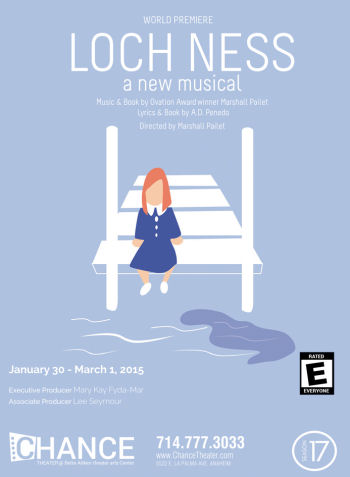
 This year seems to be starting out on a particular theme — one that is emphasizing creativity and expressiveness. We saw that creativity earlier this year at ZJU’s 50 hour theatre; it was also apparent in the creative reimagining of Pulp Fiction. We’ve seen super expressiveness on stage as well, both with the puppeteers of Avenue Q, the clever ideas behind Serial Killer Barbie, and the wonderfully expressive lead in Redhead. We saw both combined in the new musical now playing at the Chance Theatre (FB) in the Anaheim Hils: Loch Ness.
This year seems to be starting out on a particular theme — one that is emphasizing creativity and expressiveness. We saw that creativity earlier this year at ZJU’s 50 hour theatre; it was also apparent in the creative reimagining of Pulp Fiction. We’ve seen super expressiveness on stage as well, both with the puppeteers of Avenue Q, the clever ideas behind Serial Killer Barbie, and the wonderfully expressive lead in Redhead. We saw both combined in the new musical now playing at the Chance Theatre (FB) in the Anaheim Hils: Loch Ness.
Loch Ness, a new musical by the father/son team of A. D. Penado (FB) (lyrics and book) and Marshall Pailet (FB) (director, music, books), tells the story of the Loch Ness monster, of course (although that term is a little pejorative :-)). But that’s only part of the story in Loch Ness (the musical). The real focus of the story is on belief, holding on to that belief in the face of reality, recognizing when to give up on a mistaken belief, and coming to the realization — when you do so — that what you gain by giving up may be much more than you gain by holding on. Loch Ness (the musical) is a story about relationships and love — but it isn’t the traditional romantic love that was celebrated in the Chance’s last musical, She Loves Me; rather, the love celebrated in this musical is the love between parent and child, and between child and parent. The two notions — belief and love — combine to create the necessary “I want” that propels the story forward, and provide to be what, ulitmately, make the story successful.
So what is the story behind Loch Ness? It centers around the Westerbook family: the father, Dr. Thomas Westerbrook and his daughter, Haley Westerbrook (and her pet frog, Mudpie). The Westerbrooks recently lost Haley’s mother in an aircraft disappearance over the North Sea. After searching and searching and searching — exhausting all family funds — Dr. Westerbook gave up the search. The only work he could find was for a wealthy patron, Leana Callaghan, who had once seen the Loch Ness monster when she was young and snapped a picture of her (which looks like a smudge). After a timely inheritance, she now had the funds to prove she exists. She hired Dr. Westerbrook to do the search. Haley comes along, although she’s supremely pissed at her father for giving up the search for her mom and keeps running away and rebelling. Assisting Dr. Westerbrook in the search are Captain Jameson (who prefers to be called “CJ”, the C being for Captain) and two French research assistants, Pierre and Eclair. Not surprisingly, during one of her rebels, Haley discovers Nessie. Nessie, too, is searching for her mother and wants to return to the North Sea to find her. She believes that she can, if only she can get big enough. This gets to the underlying myth of this show: Nessie shrinks when she is photographed and reality comes into play; she grows when people simply believe in her. This starts Haley’s quest: to get people to believe in Nessie while preventing her father’s mission (and Lady Callaghan’s mission) to provide photographic proof of Nessie. If Haley succeeds, Nessie has promised her that she will take her to the North Sea to find her mother. Lurking behind everything is the mysterious “Oiler”, who keeps muttering about things in the Scottish highlands. I won’t spoil the twists and turns of the adventure along the way, but suffice it to say that by the end of the show, both Haley and Nessie have found what they needed, even if it was not necessarily what they believed. The overall effect was just beautiful, creative, and touching.
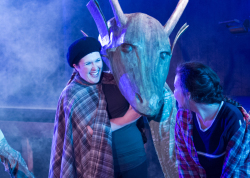 Much credit goes to the direction of Pailet (FB), the choreography of Kelly Todd (FB), and the masterful scenic and puppet design of Fred Kinney (FB) and Megan Hill (FB). These folks used creative collaboration to create an environment where Nessie came to life through the work of multiple puppeteers. Using the same technique seen in Avenue Q, the puppeteer’s faces were visible and were amplifying the limited expressiveness of the actual puppet head (which was a single-rod puppet). Katie Brown (shown to the right) served as the main face and voice of Nessie (more on her later), while other actors doubled controlling other parts of Nessie and were equally visible and expressive. It was remarkable to see and emphasized why intimate theatre is a necessity — in the scale of a large auditorium, this magic would be lost for much of the audience.
Much credit goes to the direction of Pailet (FB), the choreography of Kelly Todd (FB), and the masterful scenic and puppet design of Fred Kinney (FB) and Megan Hill (FB). These folks used creative collaboration to create an environment where Nessie came to life through the work of multiple puppeteers. Using the same technique seen in Avenue Q, the puppeteer’s faces were visible and were amplifying the limited expressiveness of the actual puppet head (which was a single-rod puppet). Katie Brown (shown to the right) served as the main face and voice of Nessie (more on her later), while other actors doubled controlling other parts of Nessie and were equally visible and expressive. It was remarkable to see and emphasized why intimate theatre is a necessity — in the scale of a large auditorium, this magic would be lost for much of the audience.
 Musically, Loch Ness was well-assembled as well. A complaint with many new musical writers these days is that they don’t know how to write musicals. The songs seem like the novelty songs of old — dropped in because they wanted music at that point, but the music simply repeats what had been said in the story, or provides an entertaining diversion. This was a problem in the recent Serial Killer Barbie. I’m pleased to say that this musical gets it right — the songs are integral to the story and propel it along. I’d give specific examples with the names of the song, but (alas) no song list was provided and one could not be found online (even at the press site, hint hint). A few musical moments do stick in my mind the morning after. In Act I, there is the moment where Nessie and Haley express their shared hope, their desire to fly back to their mothers. This is just a beautiful song that moves the story along perfectly. Another song that sticks in my mind is the opening to Act II, where CJ, Pierre, Eclair and the Oiler express their joy at finally realizing Nessie is real. The creative musical nature of the number was remarkable. Lastly, there is a touching song in Gaelic that perfectly captures the emotion between parent and child.
Musically, Loch Ness was well-assembled as well. A complaint with many new musical writers these days is that they don’t know how to write musicals. The songs seem like the novelty songs of old — dropped in because they wanted music at that point, but the music simply repeats what had been said in the story, or provides an entertaining diversion. This was a problem in the recent Serial Killer Barbie. I’m pleased to say that this musical gets it right — the songs are integral to the story and propel it along. I’d give specific examples with the names of the song, but (alas) no song list was provided and one could not be found online (even at the press site, hint hint). A few musical moments do stick in my mind the morning after. In Act I, there is the moment where Nessie and Haley express their shared hope, their desire to fly back to their mothers. This is just a beautiful song that moves the story along perfectly. Another song that sticks in my mind is the opening to Act II, where CJ, Pierre, Eclair and the Oiler express their joy at finally realizing Nessie is real. The creative musical nature of the number was remarkable. Lastly, there is a touching song in Gaelic that perfectly captures the emotion between parent and child.
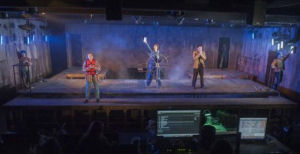 I mentioned the set design earlier with the puppet, and I’d like to discuss it before I go into the actors. The picture to the right, from Marshall Pailett’s website (there were no good set pictures on the Chance website), gives you an idea. There was this large wooden sided pit with Viking wood carvings in front, topped by a movable bridge that could slide back and forth. The bridge represented the ship or land; Nessie and her puppeteers moved in the pits, ducking under the bridge as necessary. At the back of the set were wooden doors that could open up to prove a few specific locations. Dealing with the movable bridge and its back and forth was a different style of choreography on top of the few somewhat traditional dance numbers (this was more of a performance than a dance show). The set worked magic to create the sense of place, especially in the opening where fog machines were used to great effect to create the image and feel of steam rising off the Loch, and the bridge creating the image and feel of being out on the water. You may have heard the phrase “stage magic”. This was stage magic — art and imagination combined to create something real but not realistic, something that bridged the world between the imaginary and the concrete. About my only worry is whether this would scale — it wouldn’t work in many theatres, might lose the magic in large theatres, and there could be problems (as noted in the talk-back) in theatres with balconies. Then again, those are problems you want to have to solve, because that means a future life for the show.
I mentioned the set design earlier with the puppet, and I’d like to discuss it before I go into the actors. The picture to the right, from Marshall Pailett’s website (there were no good set pictures on the Chance website), gives you an idea. There was this large wooden sided pit with Viking wood carvings in front, topped by a movable bridge that could slide back and forth. The bridge represented the ship or land; Nessie and her puppeteers moved in the pits, ducking under the bridge as necessary. At the back of the set were wooden doors that could open up to prove a few specific locations. Dealing with the movable bridge and its back and forth was a different style of choreography on top of the few somewhat traditional dance numbers (this was more of a performance than a dance show). The set worked magic to create the sense of place, especially in the opening where fog machines were used to great effect to create the image and feel of steam rising off the Loch, and the bridge creating the image and feel of being out on the water. You may have heard the phrase “stage magic”. This was stage magic — art and imagination combined to create something real but not realistic, something that bridged the world between the imaginary and the concrete. About my only worry is whether this would scale — it wouldn’t work in many theatres, might lose the magic in large theatres, and there could be problems (as noted in the talk-back) in theatres with balconies. Then again, those are problems you want to have to solve, because that means a future life for the show.
Turning to the performances — they were remarkable (however, I’ve come to expect nothing less from the Chance Theatre (FB)). In the lead tier were Julia Cassandra Smith (FB) as Haley, and Katie Brown (FB) providing the “face” and voice of Nessie. Both were remarkable. Smith’s Haley was youthful and playful and gave off a delightful depth of spirit — and she had a wonderful voice. Brown’s face was remarkably expressive and just made you melt; again, she also had a delightful voice that worked quite well with Smith’s.
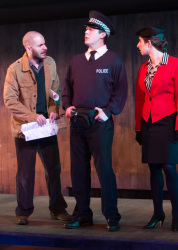 In the second character tier were Jackson Tobiska (FB) as Dr. Thomas Westerbrook and Angeline Mirenda (FB) as Leana Callaghan. We’ve seen Tobiska before in both Triassic Parq and Lysistrata Jones. He plays the scientist well, and captured the fatherly nature of the character quite well. He had a very nice singing voice. Mirenda was seemingly the villain of show — the women hellbent on proving the existence of Nessie. She captured that aspect of the character well both in look and performance.
In the second character tier were Jackson Tobiska (FB) as Dr. Thomas Westerbrook and Angeline Mirenda (FB) as Leana Callaghan. We’ve seen Tobiska before in both Triassic Parq and Lysistrata Jones. He plays the scientist well, and captured the fatherly nature of the character quite well. He had a very nice singing voice. Mirenda was seemingly the villain of show — the women hellbent on proving the existence of Nessie. She captured that aspect of the character well both in look and performance.
As we enter the next tier, we’re getting to characters who not only played their “name” roles, but who also helped manipulate the puppets. The first half were the main ship characters: Alex Bueno (FB) as CJ, Keaton Williams (FB) as Pierre, and Gina Velez (FB) as Eclair. We’ve seen both Bueno and Williams before in Parq and were impressed with them then; they were perfection here. Velez is new to us but was also fun to watch. As their name characters they were delightful — both in the little comedy asides (in particular, CJ and the coffee cup at the beginning of the show, and the interactions between Pierre and Eclair) and in their singing and dancing (as I noted before, the opening of Act II is just spectacular). Williams and Velez were also notable for their manipulation of Nessie — especially when they were working close to Smith’s Haley, where the expressiveness of their faces (especially Keaton William’s face) was indescribable for what it added to the show. You can see the three of them in the image to the right.
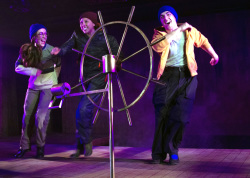 Rounding out the characters in the show were Corky Loupe (FB) as the Oiler, Matt Takahashi (FB) as Angus Ogilvie, and Laura M. Hathaway (FB) as the Balladeer. We saw all three before in She Loves Me. These roles were minor, although Louple’s Oiler provided a wonderful comic relief in his few songs and asides — in particular with the toaster joke (no, not that toaster joke) and the percussion in the Act II opener. I couldn’t quite figure out the purpose of the Balladeer; I saw her more as an echo of the mother who was lost at sea (and it might have been better to refer to her that way). All three provided other background characters and puppet manipulation, and were wonderful in those aspects (in particular, the pub crawl scene).
Rounding out the characters in the show were Corky Loupe (FB) as the Oiler, Matt Takahashi (FB) as Angus Ogilvie, and Laura M. Hathaway (FB) as the Balladeer. We saw all three before in She Loves Me. These roles were minor, although Louple’s Oiler provided a wonderful comic relief in his few songs and asides — in particular with the toaster joke (no, not that toaster joke) and the percussion in the Act II opener. I couldn’t quite figure out the purpose of the Balladeer; I saw her more as an echo of the mother who was lost at sea (and it might have been better to refer to her that way). All three provided other background characters and puppet manipulation, and were wonderful in those aspects (in particular, the pub crawl scene).
Music for this show was prerecorded to provide the lushness that that the composer wanted. Mark Sonnenblick (FB) was the Musical Director, and Ryan O’Connell (FB) was the orchestrator. I do have a few wishes for the music: (a) that a song list was provided somewhere — this not only helps those who want to share the show with our friends, but helps match the songs with the actors that performed them (a boon to the actors); and (b) that there was a cast recording. I strongly suggest that a Kickstarter be considered for such a recording (hell, if Evil Dead: The Musical or Now. Hear. This. can do it) — it can not only promote the show, but would preserve this wonderful cast (and might even provide income for the Chance). (PS: There also needs to be a scene list in the program)
I’ve talked before about the wonderful set and the Nessie puppet. Remaining credit in those areas goes to Baxley Andresen (puppet mechanics/fabrication) and Amy Ramirez (FB) (props designer). The sound design was by Ryan Brodkin (FB), and was notable not only for the quality of the amplification (which did occasionally overpower the singers, but that was positional and got adjusted during the show), but more so for the ambient noise that was provided that increased the feeling that one was at the Loch. Lighting was by Jonathan Daroca (FB) and it effectively established the mood. I particularly noted the effect of the LED lighting used on the side; I don’t recall this use of LED lighting before at the Chance. Costumes were by Rachael Lorenzetti and worked quite well. The tight skirt and hose on Lady Callaghan actually made her character seem more evil; Haley’s outfit made her more kid-like, and the outfits of the crew made them appear to be suited for a ship. There were also all those woolens and plaids! There was no credit for makeup or wigs. Remaining show credits: Nora Ives (FB) (Associate Director), Nichole Schlitt (FB) (Stage Manager); Mary Kay Fyra-Mar (FB) (Executive Producer); Lee Seymour (FB) (Associate Producer). I’m not going to list all the Chance staff positions that were in the program; you can find them listed on the Chance website. Two that are worthy of note are Oanh Nguyen (FB), the artistic director, who presumably picked this show for the season (good choice!); and whomever is the marketing director (I’m guessing Molly Dewane, based on a web search), for her well-done speech before the show.
Loch Ness: A New Musical continues at the Chance Theatre (FB) until March 1. Tickets are available through the Chance website; they may also be available through Goldstar. The show is well worth seeing.
The Chance Theatre is lucky — they are in Orange County and not affected by the proposed changes to the 99 seat plan from AEA. These changes, if enacted, could create major changes in the intimate theatre scene in Los Angeles County — and have the potential to at worst decimate it, and at best move many small theatres to eschew the use of actors belonging to Actors Equity or other unions. This will hurt everyone — actors, producers, and audience members. I strongly urge everyone to read about the proposed changes. Colin Mitchell and Bitter Lemons has been doing a remarkable job of being THE source for information about this. Read. Learn. If you are in a position to do so, speak up about it. Alas, I don’t believe Actors Equity would care about the opinion of audience members (that is certainly not their constituency); they likely don’t care about the Producers either (or they wouldn’t have proposed this). They certainly don’t understand the Los Angeles theatre scene. Still, if can never hurt to let your opinions be known — as audience members, we can also choose to stay away from Equity productions under this proposal — after all, a show without an audience. Whatever you do, be out there to support LA Theatre and Southern California theatre.
Dining Notes: Yet again we had an excellent meal before the show at True Shabu. Wonderful organic hot-pot cooking, with farm fresh and healthy ingredients. It’s a shame it is so far away, or we would eat there more often.
Ob. Disclaimer: I am not a trained theatre critic; I am, however, a regular theatre audience. I’ve been attending live theatre in Los Angeles since 1972; I’ve been writing up my thoughts on theatre (and the shows I see) since 2004. I do not have theatre training (I’m a computer security specialist), but have learned a lot about theatre over my many years of attending theatre and talking to talented professionals. I pay for all my tickets unless otherwise noted. I believe in telling you about the shows I see to help you form your opinion; it is up to you to determine the weight you give my writeups.
Upcoming Shows: Theatre continues this afternoon with “The Threepenny Opera” at A Noise Within (FB). The weekend of February 21 sees us in Burbank for Inside Out at the Grove Theatre Center (FB). February closes with two more Burbank performances: the Good People Theatre Co (FB)’s production of Maltby/Shire’s Closer Than Ever at Hollywood Piano in the afternoon, and “The Road to Appomattox” at The Colony Theatre (FB) on February 28. March is equally busy, with the MRJ Man of the Year dinner on March 7 (and a Purim Carnival at TAS the next day), “Carrie: The Musical” at La Mirada Theatre for the Performing Arts (FB) on March 14, a “Drowsy Chaperone” at CSUN on Friday March 20, “Doubt” at REP East (FB) on Saturday March 21, “Newsies” at the Pantages (FB) on March 28, followed by Pesach and the Renaissance Faire on April 11. Other than the Faire, April is pretty much open (as is May), but I expect that to start changing soon (for example, I just booked “Loopholes” for the first weekend in May). As always, I’m keeping my eyes open for interesting productions mentioned on sites such as Bitter-Lemons, and Musicals in LA, as well as productions I see on Goldstar, LA Stage Tix, Plays411.


 Finally, it’s Saturday. This has been a busy week — I’ve been accumulating articles, but haven’t had time during the week to post them. Before we jump into the stew, Happy Valentine’s Day to those that observe. What are we doing? We’re going to a
Finally, it’s Saturday. This has been a busy week — I’ve been accumulating articles, but haven’t had time during the week to post them. Before we jump into the stew, Happy Valentine’s Day to those that observe. What are we doing? We’re going to a  It’s Saturday, and that means it is time to clear out the links. I’m doing it a little earlier than usual today, as I’ve got a Bat Mitzvah service at 9 AM and the party afterwards that will take up much of the day:
It’s Saturday, and that means it is time to clear out the links. I’m doing it a little earlier than usual today, as I’ve got a Bat Mitzvah service at 9 AM and the party afterwards that will take up much of the day: Yesterday, when I got home and caught up on Facebook, I discovered that some Facebook friends had posted the image below, which was shared from the “National Vaccine Information Center” (an innocuous sounding group, until you visit
Yesterday, when I got home and caught up on Facebook, I discovered that some Facebook friends had posted the image below, which was shared from the “National Vaccine Information Center” (an innocuous sounding group, until you visit 

 A Cantors Concert. When you hear that phrase, you probably think of a long religious service with lots of liturgical music. While, indeed, that is a form of a musical presentation given by a cantor, it is part of a worship involving a congregation (which you must never refer to as the “audience”, as Rabbi Sheryl always used to remind me). A true concert provides the opportunity for a cantor to perform in front of an audience. It provides the opportunity for a cantor, who is a trained music professional as well as a liturgical leader, to make selections designed to showcase their talent. It also allows the community to see a cantor as more than just a religious musician, to see the cantor as a fully-rounded entertainer. These concerts can also serve as fundraisers for a congregation, where congregants, friends, and family can support both the cantors on stage and the congregation as a whole through their paid attendance. Given this, one can look at a “cantors concert” through multiple aspects: the performance aspects, the fund-raising success, and the extent to which it deepened the relationship between the audience (which contained some percentage of congregation members) and the cantor.
A Cantors Concert. When you hear that phrase, you probably think of a long religious service with lots of liturgical music. While, indeed, that is a form of a musical presentation given by a cantor, it is part of a worship involving a congregation (which you must never refer to as the “audience”, as Rabbi Sheryl always used to remind me). A true concert provides the opportunity for a cantor to perform in front of an audience. It provides the opportunity for a cantor, who is a trained music professional as well as a liturgical leader, to make selections designed to showcase their talent. It also allows the community to see a cantor as more than just a religious musician, to see the cantor as a fully-rounded entertainer. These concerts can also serve as fundraisers for a congregation, where congregants, friends, and family can support both the cantors on stage and the congregation as a whole through their paid attendance. Given this, one can look at a “cantors concert” through multiple aspects: the performance aspects, the fund-raising success, and the extent to which it deepened the relationship between the audience (which contained some percentage of congregation members) and the cantor.